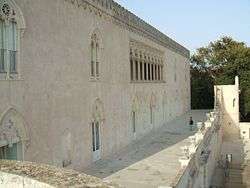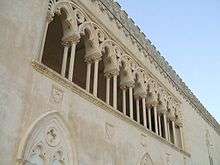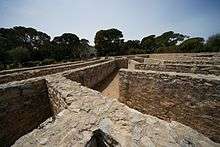Donnafugata Castle
| Donnafugata Castle | |
|---|---|
|
Native name Italian: Castello di Donnafugata | |
 An angled view of the balcony above the entrance to the castle. | |
| Location | District of Donnafugata, Ragusa, Sicily, Italy |
| Nearest city | Ragusa |
| Coordinates | 36°52′55″N 14°33′49″E / 36.88194°N 14.56361°ECoordinates: 36°52′55″N 14°33′49″E / 36.88194°N 14.56361°E |
| Built | 14th century |
Donnafugata Castle (Italian: Castello di Donnafugata [kaˈstɛllo di ˌdɔnnafuˈɡaːta]) is located 15 kilometers (9.3 miles) away from Ragusa in Sicily, Italy.
Although the origins of this place could be traced back to the fourteenth-century most of its current Neo-Classical and Neo-Gothic appearance belongs to the 19th century.[1]
Name origin


There are many local stories that try to explain the origin of the name Donnafugata, which translates from Italian roughly as "fugitive woman" or "woman who fled". Following what the name suggests, one legend claims that Queen Blanche of Navarre, widow of King Martin I of Aragon, was in hiding from Count Bernardo Cabrera, who wanted to marry her and assume leadership over Sicily. She hid in Donnafugata Castle until it was taken under siege by Cabrera, during which Giovanni Moncada helped her flee and hide again in the Steri Palace in Palermo.[2] While this story may be true, it is not from whence the castle's name originates.
It's more likely that the name is the result of a linguistic corruption of the Arabic toponym عين الصحة ('Ayn al-Ṣiḥḥat, i.e. Source of Health). In Sicilian it turns into Ronnafuata, hence the current name.
Surrounding area
Modern era
The stone labyrinth was used for the film Tale of Tales.
References
- ↑ "Donnafugata: masseria fortificata, casina neoclassica, castello neogotico, riflessioni su una mutazione".
- ↑ Quatriglio, Giuseppe (1997). "Chapter IV: One Queen and Many Barons". A Thousand Years in Sicily (4th ed.). Legas / Gaetano Cipolla. p. 70. ISBN 0-921252-17-X.
External links
| Wikimedia Commons has media related to Donnafugata Castle. |